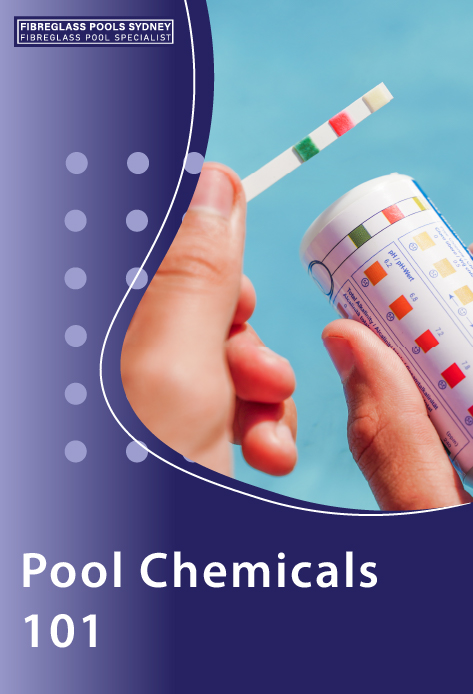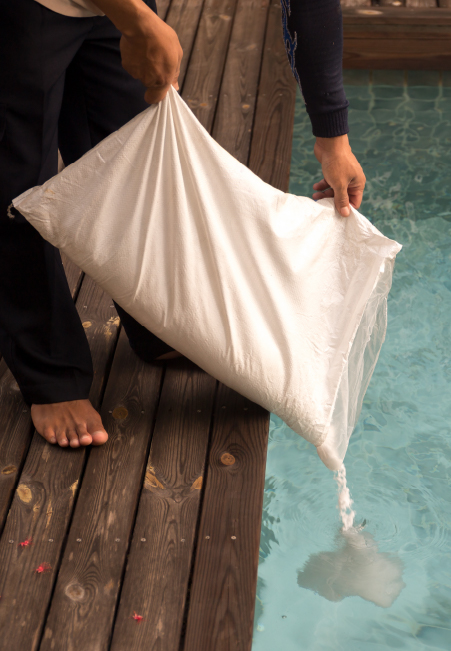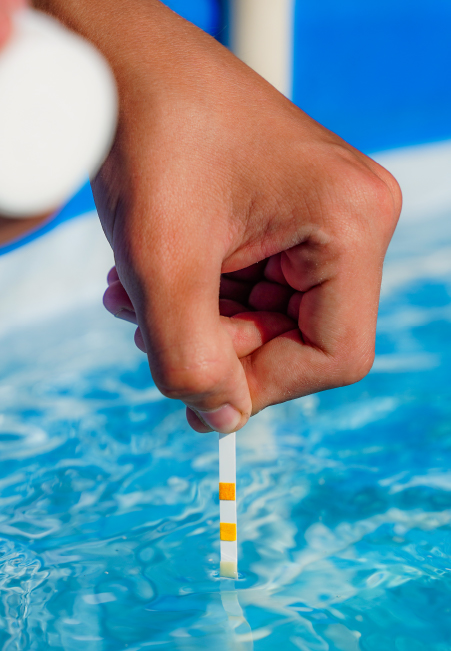Pool Chemicals 101
Don't just dip your toe, make a splash in the world of pool maintenance! Whether your aquatic escape is a respite from the summer heat or a year-round oasis, ensuring the waters remain crystal clear and safe for swimmers is a top priority for any pool owner. The key to maintaining a healthy pool isn't just the equipment or the frequent cleanings; it's the pool chemicals. Often a mysterious art to beginners, pool chemicals play an instrumental role in creating an environment that's not only inviting but also hygienic. In this comprehensive guide, we'll take a deep dive into the world of pool chemicals, illuminating what they are, why they're essential, and how to handle them safely. Whether you're an experienced pool owner looking to brush up on best practices or brand new to the pool game, this blog post has got you covered.

Understanding Pool Chemicals
Imagine chemicals as the guardians of your pool’s health. They fend off bacteria, algae, and other contaminants, ensuring your water body remains pristine. Here’s a breakdown of the pivotal compounds that make it all happen.
Chlorine: The Hero Disinfectant
Chlorine is the undisputed champion when it comes to sanitising the pool water. It swiftly eliminates harmful microorganisms, leaving behind nothing but clean H2O. From maintaining the right ‘free chlorine’ levels to shock treatments, you can rely on this trusty compound to keep illness at bay. But beware, too much of a good thing can be harmful, so find that golden middle ground.
pH Adjusters: The Balance Keepers
The pH level of your pool water should be slightly alkaline at 7.4 to 7.6. pH adjusters like sodium carbonate (soda ash) nudge the number in the right direction, preventing corrosion of pool equipment and protecting the overall pool structure.
Algaecides: The Anti-Algae Arsenal
Keeping algae at bay is crucial for an attractive and safe pool. Algaecides, which come in various forms including metallic and non-metallic, are the defenders that prevent spores from germinating into green invaders.
Stabilisers: The Sunscreen for Chlorine
Also known as cyanuric acid, stabilisers shield chlorine from the sun’s UV rays, which can quickly diminish its effectiveness. Think of it as sunblock for your pool’s sanitizer.
Calcium Hardness Increaser: Keeping Water Balanced
In regions with soft or aggressive water, adding calcium hardness increaser (calcium chloride) can prevent water from becoming corrosive.

Testing and Balancing
Consistency plays a crucial role in effective chemical management for pool maintenance. By conducting regular testing of your pool water, you can gain valuable insights into the chemical balance and understand precisely what adjustments need to be made to ensure a safe and enjoyable swimming experience. This raises the question: what is the systematic approach behind this seemingly complex chemical management? Understanding the nuances of pool chemistry can seem like a daunting task, but with a methodical approach, it becomes manageable and essential for maintaining the perfect pool environment.
When to Test? Test your pool water at least twice a week during the swimming season and once a week during the offseason.
How to Test? There are various kits available, from simple dipsticks to digital testers. Most will test for the pool’s pH, free chlorine (FC), total chlorine (TC), and combined chlorine (CC). The FC level should be at 3 ppm, the ideal TC is 1-3 ppm, and the CC should be at or near zero.
How to Balance? It’s a delicate dance. Use the chemical labels, follow instructions, and adjust in small increments. Overcompensating can lead to a cascade effect and a day of chemical rebalancing.
The Dos and Don’ts of Pool Chemicals
Deploying pool chemicals isn’t without its dangers. Mishandling them can lead to skin and eye irritation, respiratory issues, and in severe cases, be life-threatening. Here are common do’s and don’ts to stay safe:
Do Read Labels: Information is power. Always read the labels on your pool chemicals – it has crucial instructions and precautions.
Do Use Chlorine with Caution: Whether it’s in tablet, granule, or liquid form, always handle chlorine products with care. Never mix different types of chlorine, and add chemicals to water, not water to chemicals to avoid splashing.
Do Store Properly: Keep your pool chemicals in a dry place out of direct sunlight and out of reach of children and pets. Store different chemicals separately and make sure containers are tightly sealed.
Do Wear Protective Gear: When handling pool chemicals, protect yourself. A pair of gloves, safety glasses, and potentially a mask can shield you from irritation.
Don’t Overlook Safety Protocols: Always have a well-ventilated space and a nearby water supply when working with chemicals. And remember, never smoke – even outdoors – when chemicals are in use.
Don’t Forget to Shock the Pool: Shock treatments boost chlorine levels, combating chloramines (or combined chlorine) which can cause irritation and pool odour.
Don’t Ignore the Waterline: Regularly scrub the waterline to prevent a chemical buildup that can affect your pool’s chemistry.

Eco-Friendly Options
In an age where sustainability is essential, even pool maintenance is looking towards eco-friendly alternatives.
Saltwater Chlorination Systems: Replacing traditional chlorine with a saltwater system can offer a gentler, low-maintenance, and environmentally friendly chlorination method.
Mineral Systems: Adding elements like copper and silver can reduce your reliance on traditional chemicals and keep your pool water clear and algae-free.
Enzymes: These natural compounds target oils and organics in your pool water, reducing the load on your sanitizer and so keeping the water cleaner, longer.
Conclusion
Understanding the pool chemical basics goes a long way in ensuring your pool is a safe and refreshing haven. From sanitising with the right amount of chlorine to balancing pH levels and exploring eco-friendly options, the choices you make impact not only the aesthetics of your pool but also the health of those who enjoy it.
Now that you’ve added a few pages to your pool chemical playbook, go forth with confidence. Armed with knowledge, a commitment to safety, and the willingness to adapt, your pool can stay in its best condition, ready to host those sunny summer days or starlit parties. Happy swimming!
Pool Chemicals 101
Don't just dip your toe, make a splash in the world of pool maintenance! Whether your aquatic escape is a respite from the summer heat or a year-round oasis, ensuring the waters remain crystal clear and safe for swimmers is a top priority for any pool owner. The key to maintaining a healthy pool isn't just the equipment or the frequent cleanings; it's the pool chemicals. Often a mysterious art to beginners, pool chemicals play an instrumental role in creating an environment that's not only inviting but also hygienic. In this comprehensive guide, we'll take a deep dive into the world of pool chemicals, illuminating what they are, why they're essential, and how to handle them safely. Whether you're an experienced pool owner looking to brush up on best practices or brand new to the pool game, this blog post has got you covered.

Understanding Pool Chemicals
Imagine chemicals as the guardians of your pool’s health. They fend off bacteria, algae, and other contaminants, ensuring your water body remains pristine. Here’s a breakdown of the pivotal compounds that make it all happen.
Chlorine: The Hero Disinfectant
Chlorine is the undisputed champion when it comes to sanitising the pool water. It swiftly eliminates harmful microorganisms, leaving behind nothing but clean H2O. From maintaining the right ‘free chlorine’ levels to shock treatments, you can rely on this trusty compound to keep illness at bay. But beware, too much of a good thing can be harmful, so find that golden middle ground.
pH Adjusters: The Balance Keepers
The pH level of your pool water should be slightly alkaline at 7.4 to 7.6. pH adjusters like sodium carbonate (soda ash) nudge the number in the right direction, preventing corrosion of pool equipment and protecting the overall pool structure.
Algaecides: The Anti-Algae Arsenal
Keeping algae at bay is crucial for an attractive and safe pool. Algaecides, which come in various forms including metallic and non-metallic, are the defenders that prevent spores from germinating into green invaders.
Stabilisers: The Sunscreen for Chlorine
Also known as cyanuric acid, stabilisers shield chlorine from the sun’s UV rays, which can quickly diminish its effectiveness. Think of it as sunblock for your pool’s sanitizer.
Calcium Hardness Increaser: Keeping Water Balanced
In regions with soft or aggressive water, adding calcium hardness increaser (calcium chloride) can prevent water from becoming corrosive.

Testing and Balancing
Consistency plays a crucial role in effective chemical management for pool maintenance. By conducting regular testing of your pool water, you can gain valuable insights into the chemical balance and understand precisely what adjustments need to be made to ensure a safe and enjoyable swimming experience. This raises the question: what is the systematic approach behind this seemingly complex chemical management? Understanding the nuances of pool chemistry can seem like a daunting task, but with a methodical approach, it becomes manageable and essential for maintaining the perfect pool environment.
When to Test? Test your pool water at least twice a week during the swimming season and once a week during the offseason.
How to Test? There are various kits available, from simple dipsticks to digital testers. Most will test for the pool’s pH, free chlorine (FC), total chlorine (TC), and combined chlorine (CC). The FC level should be at 3 ppm, the ideal TC is 1-3 ppm, and the CC should be at or near zero.
How to Balance? It’s a delicate dance. Use the chemical labels, follow instructions, and adjust in small increments. Overcompensating can lead to a cascade effect and a day of chemical rebalancing.
The Dos and Don’ts of Pool Chemicals
Deploying pool chemicals isn’t without its dangers. Mishandling them can lead to skin and eye irritation, respiratory issues, and in severe cases, be life-threatening. Here are common do’s and don’ts to stay safe:
Do Read Labels: Information is power. Always read the labels on your pool chemicals – it has crucial instructions and precautions.
Do Use Chlorine with Caution: Whether it’s in tablet, granule, or liquid form, always handle chlorine products with care. Never mix different types of chlorine, and add chemicals to water, not water to chemicals to avoid splashing.
Do Store Properly: Keep your pool chemicals in a dry place out of direct sunlight and out of reach of children and pets. Store different chemicals separately and make sure containers are tightly sealed.
Do Wear Protective Gear: When handling pool chemicals, protect yourself. A pair of gloves, safety glasses, and potentially a mask can shield you from irritation.
Don’t Overlook Safety Protocols: Always have a well-ventilated space and a nearby water supply when working with chemicals. And remember, never smoke – even outdoors – when chemicals are in use.
Don’t Forget to Shock the Pool: Shock treatments boost chlorine levels, combating chloramines (or combined chlorine) which can cause irritation and pool odour.
Don’t Ignore the Waterline: Regularly scrub the waterline to prevent a chemical buildup that can affect your pool’s chemistry.

Eco-Friendly Options
In an age where sustainability is essential, even pool maintenance is looking towards eco-friendly alternatives.
Saltwater Chlorination Systems: Replacing traditional chlorine with a saltwater system can offer a gentler, low-maintenance, and environmentally friendly chlorination method.
Mineral Systems: Adding elements like copper and silver can reduce your reliance on traditional chemicals and keep your pool water clear and algae-free.
Enzymes: These natural compounds target oils and organics in your pool water, reducing the load on your sanitizer and so keeping the water cleaner, longer.
Conclusion
Understanding the pool chemical basics goes a long way in ensuring your pool is a safe and refreshing haven. From sanitising with the right amount of chlorine to balancing pH levels and exploring eco-friendly options, the choices you make impact not only the aesthetics of your pool but also the health of those who enjoy it.
Now that you’ve added a few pages to your pool chemical playbook, go forth with confidence. Armed with knowledge, a commitment to safety, and the willingness to adapt, your pool can stay in its best condition, ready to host those sunny summer days or starlit parties. Happy swimming!


